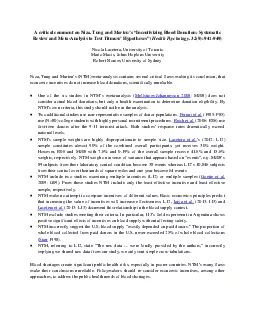

consider actual blood donations but only a health examination to determine donation eligibility By NTMs own criteria this study should not be in the analysis ghly personal recruitment procedures Reich ID: 875547
Download Pdf The PPT/PDF document "A critical comment on Niza Tung and Mart..." is the property of its rightful owner. Permission is granted to download and print the materials on this web site for personal, non-commercial use only, and to display it on your personal computer provided you do not modify the materials and that you retain all copyright notices contained in the materials. By downloading content from our website, you accept the terms of this agreement.
1 A critical comment on Niza, Tung and Mar
A critical comment on Niza, Tung and Marteus Incentivizing Blood Donation: Systematic Review and Meta-Analysis to Test Titmuss HypothesesHealth Psychology, 32(9): 941-949) Mario Macis, Johns Hopkins University Robert Slonim, University of Sydney Niza, Tung and Marteus (NTM) meta-analysis contains consider actual blood donations, but only a health examination to determine donation eligibility. By NTMs own criteria, this study should not be in the analysis. ghly personal recruitment procedures. Reich et al. (2006: R06) use first-time donors after the 9-11 terrorist attack. Both studies response rates dramatically exceed NTMs sample weights are highly disproportionate to sample size. sample constitutes almost 90% of the combined overall participants, yet receives 30% weight. However, R06 and MJ08 with 7.6% and 0.19% of the overall sample receive 41.6% and 15.6% weights, respectively. NTM weigh on inverse of variance that appears based on events, e.g. MJ08s 89 subjects from their laboratory control condition become 38 events whereas L12s 10,846 subjects 2009: G09). From these studies NTM include only the least effective incentive and least effective sample, respectively. Lacetera et al. (2013: L13) document this relationship in the blood supply context. NTM exclude studies meeting their criteria. In particular, I13s field experiment in Argentina shows NTM, referring to L12, state The raw data were kindly provided by th